Kidrobot is one of the premier designer toy companies. Their Dunny toy line has captured the imaginations of countless fans and widened the audience for vinyl toys. In addition, Kidrobot’s stores and message board serve as key resources for collectors and casual buyers alike. Recently, we had the opportunity to interview the founder and owner of Kidrobot, Paul Budnitz. Paul talks passionately and frankly about Kidrobot and also provides some insight into upcoming products as well as the future direction of the company.
Most of our readers know you as Paul Budnitz, the founder and owner of Kidrobot. Yet your bio lists a very diverse set of pursuits – programmer, artist, filmmaker, and of course businessman. Can you tell us more about yourself and your background?
My grandfather, who was the most amazing person, he was a doctor in WWII, used to say that I have some gene missing which would have stopped me from doing stupid and foolish things. I think he meant it in a good way, but he was a tough old guy and with him you never knew.
I’ve worked as a professional photographer, filmmaker, and screenwriter. I sold a screenplay (a rather sick art-horror film) this year. I’ve lived in Europe on artist’s grants, and my prints have appeared in museums.
I’ve owned three businesses.
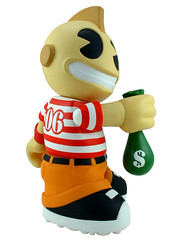
I’ve even worked as a database programmer writing engineering software.
Right now I design toys and own Kidrobot.
If you put everything you have into something (and I mean all your TIME and MONEY too, people flinch at that), then real things happen. You can’t get anywhere without making a sacrifice and taking a risk. The secret is not to be afraid of falling because there is nowhere to fall to. The very bottom is really not so far away that it can hurt us if everything falls apart.
The other secret is not to be afraid of doing something stupid because, if it wasn’t stupid, everyone would be doing it. Kidrobot is without a doubt the stupidest, riskiest thing I’ve ever done, which means it’ll probably be the most successful and most exciting.
In previous interviews and magazine articles you’ve mentioned that you started Kidrobot as a website to sell your excess designer toys and urban vinyl that you purchased from Hong Kong. Tell us a bit more about how Kidrobot started and how you chose the name?
Actually, that’s not quite accurate! I started Kidrobot because I saw these amazing toys coming out of Hong Kong and Japan. AND I wanted to make my own toys, too, and to work with a lot of the artists that I’d met over time.
Kidrobot was created very consciously to be what it is – a place to make and sell the most beautiful things in the world. I have consistently refused to compromise on that vision, and have said “no” to a dozen big companies that wanted to be involved with us and that I thought would crush our vision.
The name – erm. I wish I could tell you. It just sounded really, really good. The logo character was created by me, the artist Filth, and Tristan Eaton and was inspired partially by a very early vinyl toy created by my friend Kim at Threezero in Hong Kong, Astroboy, and a lot of other stuff.
When you were buying all those toys in Asia did you have a hunch
that selling these toys in the States would be very profitable and
viable as a business? Are you surprised that Kidrobot has been so
successful? Staying with the business theme, are you the sole owner of
Kidrobot or do you have partners?
I have silent partners, but they are really very silent and I can do what I like.
I didn’t know if this business would work, but I thought so. So I bought
way too many toys in the beginning, and had to sell them, and then we
had a business. That’s a good way to start a business, by the way,
just get yourself in a lot of trouble and have to work your way out of
it.
We still do that. We just buy or make too much risky stuff and cross our fingers someone will buy it. Some business model!
At what point did you decide to go beyond a retail outfit and create your own toy line? What was the first toy KR produced?
The first Kidrobot toy was the Cheech Wizard
toy we made with Mark Bode, followed very quickly thereafter by
Kidrobot 01 and the first Dunny. The first Dunny toy was a giveaway
for the 2003 Toycon in Hong Kong.
It came in three colors, black, red, and silver and was rather dull! I don’t even have one!!!!
Do you see any differences between today’s collectors and collectors from the “older” days? If so, what are they?
Well, there’s a little bit of a wider audience
now, and there are a lot more KIDS buying toys, which I really love to
see. There are also more fine arts collectors involved, people who are
buying these things as a long-term investment and who buy more fine art
stuff in general.
Mainly though it’s just the same but a few more people.
You must have a huge toy collection. What toys do you collect? Who
are your favorite artists as a collector? How much of your personal
taste enters into the process of choosing which artists to feature on
Kidrobot toys?
Not long ago I made an agreement with myself
that I wouldn’t buy any more toys, I’d just keep what people give me,
or what we make. I break this agreement all the time, however. Ack!!
Especially when I’m in Japan!!
My favorite toys are the toys
we make. I know this sounds egotistical, but it isn’t really, I just
relate to those toys because I was involved in them.
Which is boring so I’ll talk about the other stuff I really love.
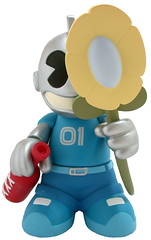
I have a very early set of 400% Devilrobots Tofu Kubricks and Evirob
(signed!) over my desk. Also a lot of Bounty Hunter toys (giant Skull
Kuns and evil ducks). I have this amazing camo 400% Kubrick that Nigo
from BAPE did. A Brothersrobber. And of course the big size King
Smurf made by Hot Toys and How2Work in Hong Kong.
And BOOSKA! I
love Booska. He’s an ultra-man era character that gets his
super-powers from ramen noodles and falls asleep if he gets tired. I
have a very beautiful full-size M1 Booska I got in Japan and a bunch of
vintage Booskas.
I have a special TWIM Bomberkid you could only buy when it was raining out.
Sorry, this room is packed with stuff, it’s impossible for me to say which I love most!
Many people talk about the toys Kidrobot and
other similar companies sell as “art toys” or alternately mini art
sculptures. Are we at that point now? Or is it a goal to be pursued?
My goal is to make beautiful
things, toys, art, whatever. Making limited editions means that we can
take risks, because if I make just 250 pieces of something, then only
250 people have to like it, and everyone else can go to hell.
Some people do see these toys as art, which I appreciate.
But I see them as toys.
On the subject of toys as art, have you given any thought to opening
a museum for designer toys? If you were to curate an exhibit, which
five essential pieces would you choose and why?
I have opened a museum, it’s called Kidrobot, and we’ve got three galleries!
I wouldn’t do anything different if I had a non-commercial space. Having the same stuff in there for years would bore me.
I
like the fact that the toys in our stores change so often. That’s my
kind of museum! A place you can go every week and there’s something
new!
It’s well-known that you and Tristan Eaton collaborated on the
design of Kidrobot’s most well-known toys including the iconic Kidrobot
series and of course Dunny. Have you created your own toy? If not,
are you planning to do so?
Yes.
Describe a typical day in running Kidrobot.
We’re such a small, low-budget company that everyone does everything.
TODAY looked like this:
Met
with someone from a big fashion house that wants to work with Kidrobot,
fixed broken computers, carried furniture around, cleaned out closets,
had lunch with a rock star, designed a sweatshirt, approved sculpts for
the new Doze toy (!), begged the bank to not bounce our checks, bought
a bunch of sneakers, forgot to eat lunch, wrote this interview, begged
the bank again not to bounce our checks again, caught up on a few
emails, headed over to Brooklyn and worked on a new toy with Tristan,
then dinner late, home finishing this interview!
Can you describe the process of bring a toy to “life”? Specifically,
how does Kidrobot decide what to make and which artists to select for
projects? Also, what are the challenges in producing toys from little
known artists and designers?
Usually someone random says, “You know, why
not make a toy with Nick Rhodes” Or, “I have this great idea for a toy,
let’s make a Godzilla with WHEELS, you know, Big Daddy Roth style!” If
it’s a good idea a group of other random people agree (usually whoever
is around and has a few minutes free) and we decide to go ahead with
the project.
We start with drawings… these become models… then
molds… then samples… then toys! The creative process is very loose,
but once it hits manufacturing and design we’re really very disciplined.
The
only challenge working with people, artists, whoever, big or small, are
egos. We don’t work with people who think they are more important than
what they are making.
Kidrobot has a rather unique role in the designer toy world. Not
only are you a retail store, but you also make your own toys and sell
them wholesale to other retail stores. Is it difficult to manage and
reconcile both aspects of your business?
Yes, it is difficult.
What works is
just to be straight and honest with everyone. We have a message board,
so we can’t pull anything over on anyone because there are about a
thousand people ready to call us on it if we mess up. Thank god for
the board. It keeps us in our place.
It’s all about clarity and
integrity, we are what we are, and people who work with us accept
that. When we screw up (and we do screw up) we usually just say so.
There’s no other way.
Honesty begets compassion and forgiveness.
Lets talk about Dunny. Was the tremendous success and popularity
anticipated at all? Care to share with us plans for Dunny series 3? In
planning for a designer series, do you focus on particular artists or
base selection primarily on submissions, or some mix of the two?
I think of a series of toys as a holistic
unit, not as a bunch of single toys. Some designs are amazing, but just
don’t work as part of the group – Series 3 is going to be off the hook,
we have such amazing designs!!!! For me it’s a matter of having the
right designs, not artist names. The past series have demonstrated our
commitment to that. Some artists were very well known, and some (at
the time) were not at all.
Kidrobot recently announced it’s first Do-it-yourself toy, the
Munny. Does the release of the Munny reduce the likelihood that
Kidrobot will produce DIY Dunnys? Is the plan to keep this toy
strictly DIY or might you produce designed editions as well?
The idea right now is for Dunny to never be DIY, and for MUNNY to always be DIY. Things change, though; you never know.
MUNNY comes with 4 blind-chase secret accessories and one of several possible coloring books.
We’re
working on several collaborations for MUNNY where specific artists
& design companies are designing their own unpainted accessories,
box, and coloring book.
How important is the concept of “limited editions” to collectability
and to the success of designer toys? Is it difficult to decide just how
limited a particular toy should be? As designer toys become more
popular is it inevitable that edition sizes will increase
significantly? Or will there always be a place for limited (say 500
pieces) and even super-limited toys?
Limited edition, for me, has to do with how
big a risk we can take with a design. The riskier the design, the
smaller the edition because then we have to please fewer people to sell
the toy. What an awesome concept!
We’ve been getting feedback from collectors that our runs were too small– 500 toys often sell out in an hour.
So
what we’re doing is making some editions that are much larger, so a
wider audience can buy them. Personally, I’d like to have an 8-inch
Dunny sit on a shelf for a month or two sometimes, so new collectors
can wander in and fall in love with it.
At the same time, we’re making other toys that
are editions of 500, 250, 100. These are some of my favorite toys as
they are super-special. You’ll see all these kinds of toys come out
this fall and winter, really edgy stuff, some of it.
Collectors of designer toys are a very passionate and vocal group.
One often-debated subject that seems to come up over and over again is
the activity of “flipping” which many define as buying toys from retail
outfits with the express purpose of quickly turning them around in the
secondary market for substantial profit. Does it surprise you that
many Kidrobot toys have gone up in value so quickly in secondary
markets such as Ebay? Is it a sign of success, a potential warning
sign or perhaps a little of both?
I don’t pay any attention to eBay. I encourage people to buy, and keep, toys they love.
Many lifestyle companies are now producing designer toys. Do you
anticipate Kidrobot evolving into a more all-encompassing brand with
both toy and lifestyle elements?
Yes, that’s happening already. We sold Polo shirts through Barneys this year. We made running shoes with Nike.
Next year will see much more in the direction of clothing, more sneakers (!!) and furniture (!!!!).
It’s surely been an exciting and amazing journey from the opening of
your first website to the major success that Kidrobot is today.
Looking back, what was the biggest mistake Kidrobot has made? What’s
the best thing that ever happened to Kidrobot? And finally, what’s the
biggest challenge facing Kidrobot and the industry as a whole?
We’ve made about a million mistakes. Every
day we just blow it in some way, then clean up our mess. That’s the
BEST thing about the company, really, we don’t have tons of experience
being “businesspeople” which means we do what we love.
Some of
the early toys and Dunnys had quality problems. But nobody seemed to
care – those seem to be the most valuable Dunnys now, maybe the
hand-made quality of them was a good thing. That was a good lesson.
It’s about the design and love that goes into it more than anything
else.
The best day I ever had is when we opened the New York
store and there was a line around the block the first day. I thought,
“Oh, this is going to work!”
And now one of our pet questions: In five years, “designer toys will be …” ?
Designer toys.
Can you give our readers some insight into what the future holds for Kidrobot?
You wouldn’t believe the amazing stuff we have
coming out this year. Dalek’s Ice-bots are really so unbelievable in
real life, as is Skumbo, we just got the first production samples.
And
we’re having a GIANT MUNNY event for charity in November, full of
celebrities and pop stars and hopefully a lot of money raised (munny?)
for kids and art. Stay tuned!!!!!
MUNNY is going to take
over the world and change people’s brains from passive
television-watching consumers to fearless artists.
I want
to open one or two more stores in the next year, and that will probably
be it for stores for us. We want to keep the energy small.
Sneakers coming this winter. Clothing collaboration with Keenan Duffty.
So much great stuff!!!
Just wait!

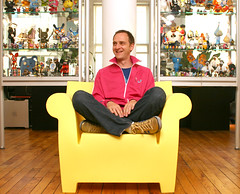
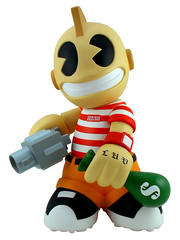
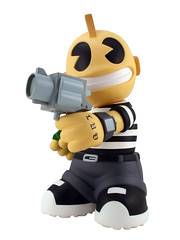
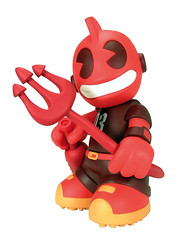
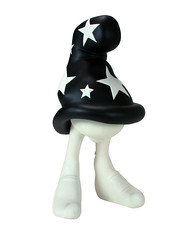
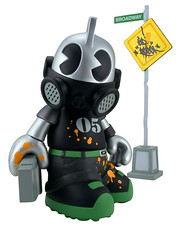
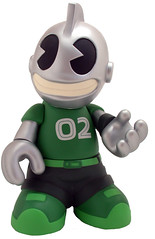
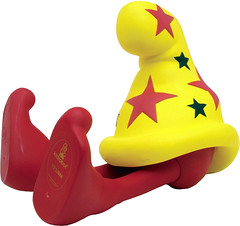
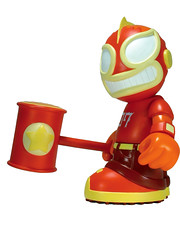
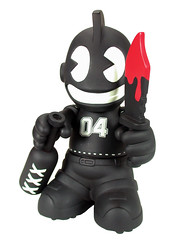
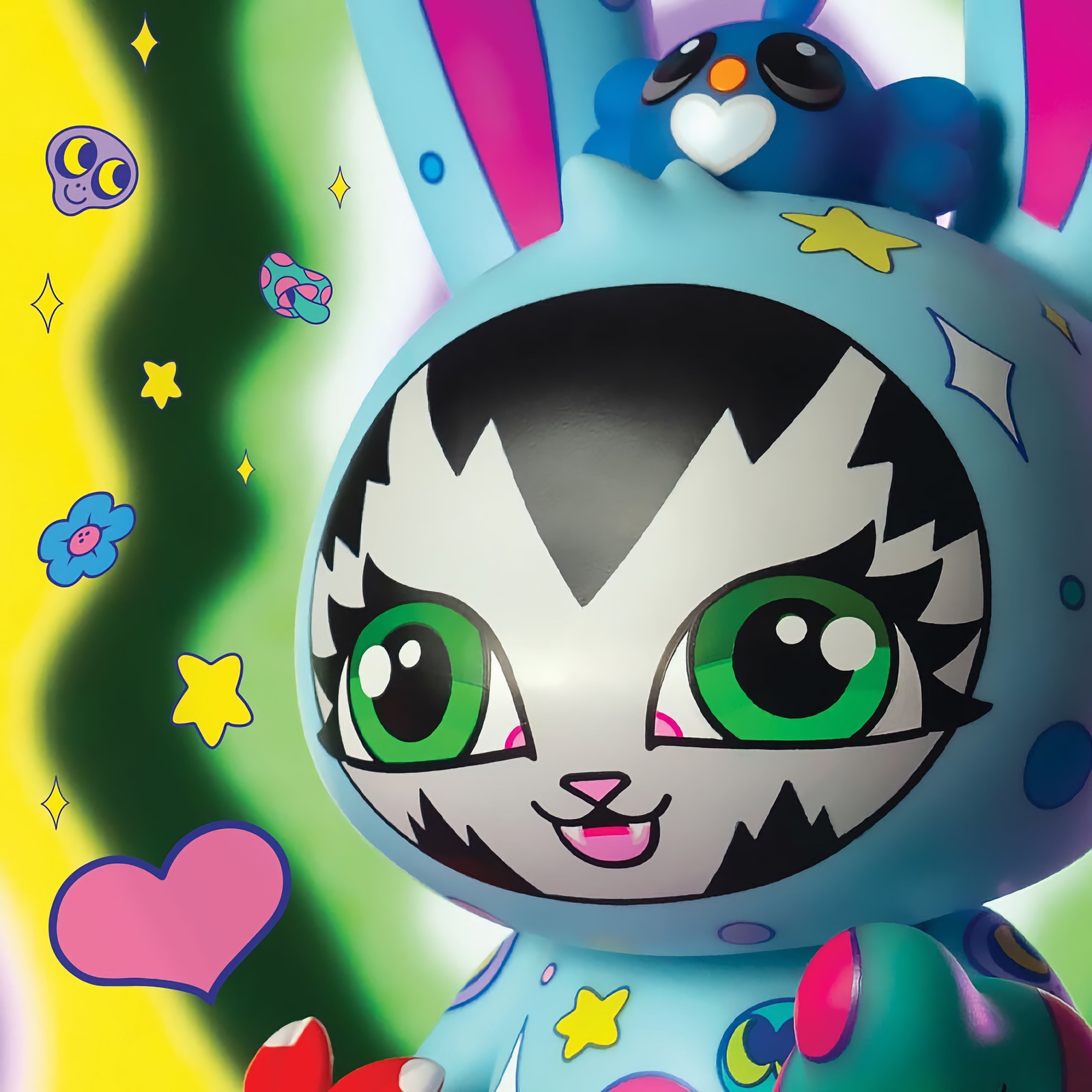
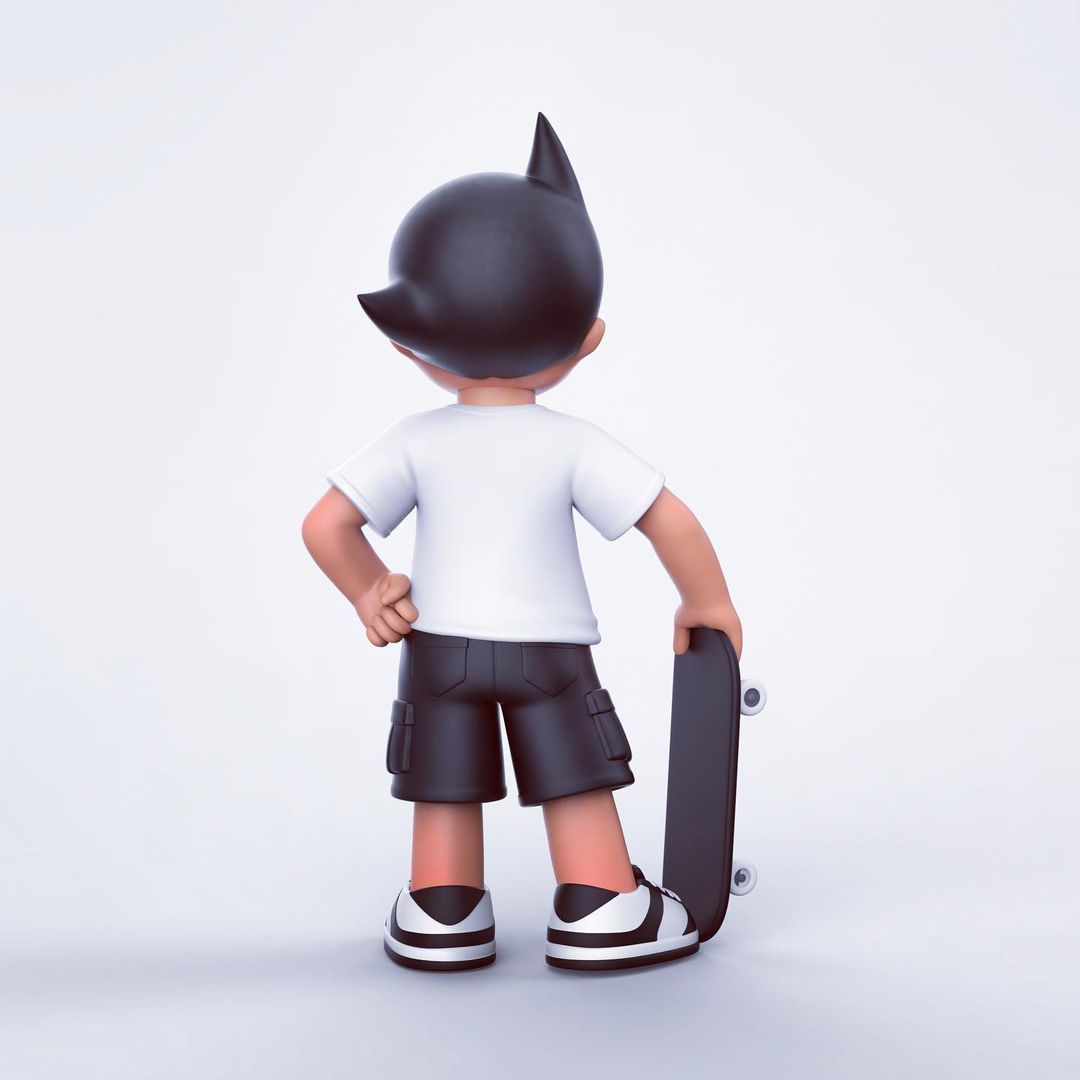
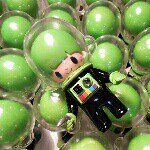

that was very inspirational.
Paul is a class act, through and through. Nice interview!
WOW, That was cool. Nice interview. -Thanks for the insight Paul…
JK
wicked interview. very insightful… 😉
did buisness with him befor very good man
Real nice to read that 🙂 hahaha, loved a day in the life of running kidrobot :-p
Some years ago I visited this funny store in SF called kidrobot. Now it’s nice to read about the man who got me into this toy mess! 😀
that was such a great, insightful interview. it’s nice to get a small peek behind the scenes of kidrobot and to know that he loves and appreciates us board members! *__*
Hope he opens a store up here in toronto Canada it would only make sense to open the store in all major cities in each country
Hi,man i´m from Brasil.I saw his babies,and is wonderful his work,i loved his pink jacket :D.
COOL MAN.
V
i met him yesterday! i was bugging out so much. i forgot to snap a picture with him. but he got was able to promote the upcoming vinyl show. =) monkeyhousetoys.com
Zed (Monkeyhouse Toys)
The Columbus College of Art & Design located in Columbus Ohio would like to have Paul Budnitz lecture to our (extremely talented & creative) students if this would be possible. We will offer an honorarium amount and all expenses paid if Paul would consider this. Please contact:
Nanette Hayakawa at nhayakawa@ccad.edu or (614) 222-6168 our web-site address is:
http://www.ccad.edu